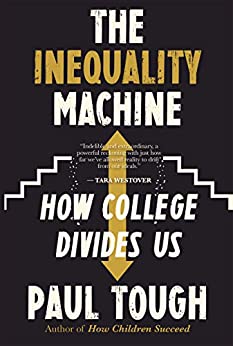More on this book
Community
Kindle Notes & Highlights
And for young Americans in Shannen’s generation, the national statistics were now painting a darker picture, one in which a college degree was no longer just a tool for upward mobility; it had also become a shield against downward mobility.
It sometimes felt as though the country was splitting into two separate and unequal nations, with a college diploma the boundary that divided them.
Young people from her corner of the Bronx didn’t often get second chances.
part because of its institutional mission. With an undergraduate population of more than fourteen thousand students, it is the largest Catholic college in the United States, founded
“Thus, when we ask universities to be ‘excellent’ and we define ‘excellence’ by input variables like SAT or ACT scores and selectivity, this is what we’re left with: Colleges who want to do the right thing have to act counter to their own interests.”
Why don’t they do more? The answer, in Boeckenstedt’s opinion, is that staying “elite” depends not just on admitting a lot of high-scoring students. It also depends on admitting a lot of rich ones.
“Maybe—just maybe—the term ‘elite’ means ‘uncluttered by poor people,’” Boeckenstedt wrote. “And maybe that’s the problem.”
When you’re socially isolated and worried about money and struggling in all your classes, it doesn’t feel like three distinct problems. It feels like one big problem.
Their hypothesis is that there are certain moments in our lives, like having a first child or enrolling in college, that are so deeply disorienting that they scramble our personal narrative—the story we tell ourselves about who we are.
The third possible reason for the ubiquity of the wealthy-welder myth is less benign: If we are able to persuade ourselves that there are plenty of lucrative opportunities available for young people like Orry who didn’t much like high school, it absolves us of our shared responsibility to address the reality of his limited economic prospects.
What got me was the fear of not being able to get myself out of the food-service industry because I didn’t have the right education. It’s like a prison.”
It’s just crazy how talented people can be, and intelligent—but it’s going to college that matters.”
that mobility through higher education is possible when you work extraordinarily hard in high school, graduate at the top of your class, and then get unusually lucky, both in the schools that choose to admit you and the professors and advisers and mentors you encounter once you enroll—and that even then, the path through college can often be difficult and lonely and strewn with unexpected obstacles.
So Treisman’s first lecture was full of positive words about belonging: You’re a Longhorn. You’re a mathematician. You’re a future leader. You’re one of us.
And that was the idea. If the students were confused together, the divisions between them would start to dissipate.
But in fact, that stress is an indicator that your understanding is deepening. It’s not a sign that you’re not learning. It’s a sign that you are learning.”
Only 48 percent of high schools, nationally, offer a course in calculus;
Schools with a lot of white students are almost twice as likely to offer calculus as schools with a lot of black and Latino students. There is a divide by social class, as well. A third of students at private schools take calculus in high school, compared to about a sixth of students at public schools.
Treisman knew that those students, especially, were likely to be feeling anxious about their place in 408C, in the university, and in life.
If we now want to nudge our country back in that direction, we might begin by embracing a principle that seemed self-evident to Americans a century ago, but is less widely acknowledged today: Our collective public education benefits us all.
The levers for change are all around us. We can affect them as students, as parents, as educators, and as citizens. We just need to decide which way we want to pull.
For lower-income students, who are disproportionately Black, Latinx, and Native, as well as rural students, preparing is on them. That is a classist and racist expectation.
The original deal was simple and straightforward: the public will invest in your education until you’ve gathered enough skills to earn a family-supporting middle-class wage.


